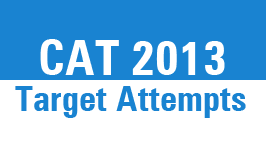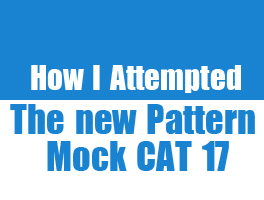The first in my series of ‘One down, four more to go’ exams is IRMA. I’ve always maintained that to defeat your enemy, you must fully know it first. Here’s a complete 101 to the exam – so even if you’re going in completely clueless, this should make you some sort of an expert on the paper yourself.
After CAT the next big entrance test, IRMA, is scheduled for 11th November. The institute is top notch and was the first in India to launch MBA in Rural or Agri-Business. Unfortunately the institute attracts less than 15,000 applicants due to the tag of Rural Management. The small number of applicants though is good news for the aspirants as it increases the chances of success of those who have applied to IRMA. With around 10 days to go, let us have a good look at the paper pattern, identify the focus areas and work out our strategy for the paper.
The Structure
IRMA is a 120 minute test with 200 questions that are divided into four sections. Unlike CAT each question in IRMA has 5 choices with +1 for every correct answer and a -¼ for every incorrect answer. The paper is divided into 4 sections as given below:

There are no sectional time limits and the students have the freedom to allocate time to the four sections as per their convenience. To have a better understanding of the paper and how to prepare for it let us look at each section separately based on the past IRMA papers.
English Comprehension: This is by and large a Vocabulary and Reading Comprehension paper with a bit of grammar and para jumbles thrown in. Till last year the 40 questions in this section were typically broken into 15 questions in one RC passage, 10 questions of Cloze Test and 15 questions from English Usage. In the last two years the questions from English Usage have been from, Grammar, Para Jumbles and Sentence Completion (2 blanks). This year too I expect a similar breakup of questions. There could be 2 RC passages with 10 questions each and a proportionate increase in the Vocab and English Usage questions.
The RC passage is typically less than 800 words and on a social issue. Most of the questions are factual with a couple of inferential or “title of the passage” questions thrown in. The questions can be easily answered by referring to the passage again, if required. Interestingly 4 – 5 synonym-antonym questions are also asked based on the highlighted words in the passage and these can be answered without even referring to the passage.
The 10 questions of cloze test are usually easy and you would struggle to get them wrong. Any Bank PO guide or online resource will give you practice questions for cloze test. Sentence completion too is easy and after CAT grammar in IRMA will be a cakewalk. The para jumbles last year were difficult primarily because of the length of the statements but could be answered with ease by using the choices. The new question type of identifying the sentence starter would have posed a problem for most of the students.
The 15-20 questions of RC can be attempted in 10-15 minutes, cloze test and sentence completion can be attempted in 7-8 minutes and the rest of EU should be given another 7-8 minutes. The 30 minutes given to this section should result in 35-40 attempts. If English is your area of strength you should target 45 questions in 30 minutes or attempt 40 questions in 25 minutes. A score in the region of 22-23 should be sufficient to clear the sectional cutoff this year.
Quantitative Ability: After CAT with it complicated reasoning this QA section will come as a relief to many. The QA section in IRMA has Arithmetic, Speed Calculation, Probability and DI focus. This is a calculation and a direct formula application paper with hardly any reasoning involved. In DI too the data sets are easy to understand the questions are direct and involve only simple calculations of average, difference, percentage change and highest-lowest. The 2011 paper however had difficult numbers which made calculation a bit difficult.
Against the norm, in 2011, 40 out of the 50 QA questions were from DI. It has 8 data sets with 5 questions each. I do not expect this to be repeated and feel that it will be a balanced paper with an almost equal split between QA and DI.
I suggest that you target 40 attempts in this section in 35 minutes and ensure a minimum score of 22 to clear the sectional cutoff.
Analytical Reasoning: This section has a good mix of questions from Analytical Reasoning (AR) and Verbal Reasoning (VR). This year number of questions in this section will increase from 50 to 60 questions
AR consists of questions from arrangement, directions, coding-decoding, series, blood relations, selection criteria and mathematical operators, most of these questions are easy to moderately difficult and can be comfortably attempted.
The VR questions are usually the difficult part of this section. These comprise questions from deductive logic, critical reasoning, statement-assumption-conclusion, cause-effect, syllogism, strong/weak arguments, odd word out etc. Here some of the questions are difficult and one needs to exercise caution.
Since both AR and VR are equally represented you obviously should first maximise your score by attempting questions from your area of strength and then move on to the other questions. My suggestion is to give this section 35-40 minutes and target 35-40 attempts. A score of 22-23 should be enough to clear the cut off.
Issues of Social Concern: This is usually the make or break section in IRMA but with the reduction of the number or questions from 60 to 40, it has made the life of students a bit easy. It has questions from what can be loosely called General Awareness but with a focus on social issues and issues that concern the masses of the country especially in the rural areas. Hence questions have a focus on the schemes of Government of India, agriculture and rural issues, issues related to poverty alleviation, economics etc. While some questions in this section are reasonably tough,till last year one could answer about 30-35 out of 60 questions if one had a habit of reading newspaper regularly. Elimination of choices can be put to good use in this section.
In this section there is no “maybe” either you know or don’t know the answer, hence reading the question and marking the answer or leaving it immediately is the preferred way of working. Hence I suggest 10 minutes for this section for about 25-30 attempts. The cut off for this section should not be more than 20 marks.
Strategy for the paper
While you can decided on the sequence in which to attempt the sections based on your strengths and comfort my suggestion would be to start with Issues of Social Concern and then move on to the other sections based on your comfort level.
Since there are no sectional time limits in IRMA hence time management is of utmost importance, I would like you to be sure of the time you should be spending in each section.
My recommendation is to assume this to be a 110 minute paper and spend the first 5 minutes in going thru all sections of the paper to understand the change in the question breakup in English Comprehension and Reasoning. Based on these changes decide the time allocation for the sections. 10 minutes for Issues of Social Concern, 35 minutes for QA, 35-40 for Reasoning and AR and 25-30 minutes for English Comprehension is my recommendation but you should fine tune this based on your strengths.
An alternate approach would be to not scan the paper at all. Start with 10 minutes to Issues of Social Concern, 30 minutes to QA, 35 to Reasoning and 25 minutes to English Comprehension. In this time attempt only the easy and less time consuming questions of each section and ensure that you clear the cutoff. The remaining 20 minutes should be used to maximise your total score by attempting questions from the section(s) which you are most comfortable with.

All the best 😀
More on the exam in a complete 2 hr mega session on ‘How to crack IRMA’. Register on Classapart here.










great drill down sir.
didn’t expect that i would encounter such a valuable website in the midst of my frantic search of gk material for irma.
Just wanted to ask weather these gk compendiums (irma &iift ) are only for cl students.if not so from where can i download them.
Rahi, these are for CL students but you can borrow from them 😉
thank you sir…
ok,thank you sir…
sir,
we have yet not received the irma admit card and therefore we are not able to register for webinar, what to do in this case
Will have it reviewed tomorrow.
sir
what score wld be enough to have a call and get converted…?/
Sir,
Since CAT is almost over. It is a sincere request if you could keep a session on which colleges to apply according to one’s expected CAT score . If you can brief us about the top colleges and the criteria used by each colleges, cut-offs of each college, so that accordingly we can apply to colleges.
CL’s B-School Calculator will be up and ready in the next 2-3 days.
We shall also be posting articles on institute selection. Subscribe to the blog or like our FB page to keep track
http://www.facebook.com/CLRocks
Hello Sir,
I am also agree with Rajan Dokania. Please provide us the details that which colleges to apply according to expected CAT score .
It would really beneficial for us.
Sir
To register for the online session of IRMA we are supposed to upload our admit card. But we still have not received it.
Sir,
thanx for the suggestions…… my cat iz on 4th nov. then my fight start fr IRMA… can u plz suggest how can i build up in social issues section .. in these last 7 days..
Manu, download the IRMA GK compendium and attend the online GK webinars. The IRMA orientation session is on 6th.
yes i registered fr d session….
sir can u tell me , for exams like IIFT and IRMA , general knowledge till which month should be known to us ??
Focus on the 2012 only
I want to apply for IRMA now?can i do it somehow? 🙁
Unfortunately it is not possible now.